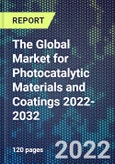The development of photocatalytic processes, materials, and chemicals offers opportunities to solve environmental issues such as clean air, pollutant degradation and provide a clean and sustainable environment via environmental remediation, CO2 photoreduction to fuels, water splitting, H2 production, interior bacterial and viral disinfection and suitable organic syntheses. Photocatalytic materials and chemicals offer environmentally-friendly disinfectant methods that are safe and effective for home use.
Of the many semiconductor heterogeneous photocatalysts, titanium dioxide (TiO2) is the most widely used due to its photostability, intrinsic electronic and surface properties, non-toxicity, cost-effectiveness, and environmental friendliness. However TiO2 photocatalysis suffers from several drawback. leading to the development of other materials such as nanoscale zinc oxide, carbon nitride g-C3N4, metal-organic framework (MOF) compounds., graphene-based photocatalysts, BiOCl, black phosphorus. ZnFe2O4, all of which are covered in this report.
Applications of photocatalytic materials and coatings include:
- Self-sterilising, long-lasting clear coatings that kill viruses and bacteria for application in the home, corporate offices, restaurants and bars, healthcare facilities, industrial workplaces, hospitality and retail stores.
- Degradation of pollutants and maintaining air quality
- Self-cleaning architectural glass
- Processes for treating industrial emissions
- Self-cleaning automotive glass
- Roof coatings to reduce pollution through the degradation of sulfur and nitrogen oxides
- Road and tunnel coatings
- Medical (self-disinfecting coatings)
- Self-cleaning exterior paints
- Coatings for the elimination of VOCs and odours in public spaces
- Water purification
- Air purification (indoor)
- Self-cleaning solar cell coatings
Applications make use of the self-cleaning, anti-fogging, antimicrobial or water cleaving properties. Antimicrobial use of photocatalysis involves three components: exposure to light, a photosensitizer, and molecular oxygen. These three components combine to produce reactive oxygen species that effectively kill a wide variety of microorganisms. Their use is growing in household applications to provide long-term disinfection.
In indoor environments, most surfaces, e.g. ceramic tiles, windows glass or paper, are gradually covered with organic matter such as oils, dirt, and smoke residue and become fouled. Use of photocatalytic coatings that are activated under visible light irradiation can address these issues. Companies are now actively seeking solutions that kill bacteria using light sources commonly present in homes (near UV and visible light) including Photocatalytic processes that kill bacteria using light sources commonly present in homes (near UV and visible light); Photocatalytic processes that produce powerful sanitizers (e.g. ClO2); and Combinations of photocatalytic processes with other chemicals that increase antimicrobial activity, particularly substances commonly used in cleaning products like chelants and surfactants.
Report contents includes:
- Market drivers and trends.
- Latest product and technology developments 2020-2022.
- Anti-viral and anti-microbial applications.
- Photocatalytic coatings in glass, building and construction, pollutant degradation, indoor air filtration, water treatment, medical facilities.
- In depth assessment of photocatalytic materials including titanium dioxide, zinc oxide, metal-organic frameworks (MOF), ZnFe204, carbon nitride, silica carbide, graphene oxide, BiOCl and black phosphorus.
- Global market revenues, historical and forecast to 2032.
- More than 60 company profiles. Companies profiled include Advanced Materials-JTJ s.r.o., AM Technology Ltd., Daicel FineChem Ltd., Envision SQ, MACOMA Environmental Technologies, LLC, Maeda Kougyou Co Ltd., Nanoksi Finland Oy, ProfMOF AS, Pureti, Swift Coat Inc and more.
This product will be delivered within 1-3 business days.
Table of Contents
Companies Mentioned (Partial List)
A selection of companies mentioned in this report includes, but is not limited to:
- Advanced Materials-JTJ S.R.O.
- AIRE
- AM Technology Ltd. (Airlite)
- Bionic Technology Holding BV
- Cardinal Glass Industries
- Cristal/Tronox
- Daicel FineChem Limited
- Diatomix, INc.
- DrivePur
- EnvisionSQ
- Fumin Co., LTd.
- Green Earth Nano Science, Inc
- Green Millenium, Inc.
- Green Science Alliance
- Heidelberg Cement
- Ishihara Sangyo Kaisha, Ltd.
- Italcementi Group
- Kaltech Co., Ltd
- Kastus
- Kon Corporation
- Kronos International, Inc.
- Life Air Iaq Ltd
- MACOMA Environmental Technologies, LLC
- Maeda-KougyouCo, Ltd
- Marusyo Sangyo Co., Ltd.
- MVX Protex
- Nanjing High Technology Nano Material Co., Ltd. (HTNano)
- Nanoksi Finland Oy
- NanoPhos SA
- NanoPhyll
- Nanotech Surface Company
- Nanowave Co., Ltd.
- Nanoyo Group Pte Ltd
- Nippon Sheet Glass Co., Ltd
- NOF Corporation
- n-tec GmbH
- NTT Advanced Technology Corporation
- Pacific Paint (Boysen) Inc.
- Panahome Corporation
- Panasonic
- PCN Materials IKE
- PJI Contract Pte Ltd.
- ProfMOF AS
- Pureti, Inc.
- Resysten
- Saint-Gobain Glass
- Shin-Etsu Chemical Co., Ltd.
- Showa Denko KK
- Souma Co., Ltd.
- Swift Coat, Inc
- Syzygy Plasmonics
- Taiyo Kogyo Corporation
- Thermo King
- TNO
- Toshiba Materials, co., LTd
- Toto
- Toyokosho Co., Ltd
- Toyota Tsusho Corporation
- Ube Exsymo Co., Ltd
- USA Nanocoat
- Yield Co., Ltd
- Zixilai Environment








